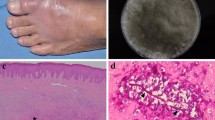Abstract
Here we report a case of cutaneous alternariosis in a 74-year-old man treated by corticotherapy for myasthenia, and presenting with papular, crusted lesions on the left elbow and the right knee. Histological examination of the biopsy specimens showed fungal hyphae associated with round-shaped cells which were highly suggestive of alternariosis. Mycological culture allowed the isolation of a dematiaceous fungus which was identified as a member of the Alternaria infectoria species-group. This was confirmed by PCR amplification and sequencing of the internal transcribed spacer domain of the gene encoding nuclear ribosomal DNA and of the mitochondrial small subunit ribosomal DNA domain. The fungus was therefore referred to the Scientific Institute of Public Health where it was identified as Alternaria infectoria, on the basis of its very small 1 or 2-celled conidia often arranged in long chains and presenting with very long secondary conidiophores. Corticotherapy was stopped and a local antifungal treatment with ketoconazole was initiated, allowing the stabilisation of the cutaneous lesions within 2 months.
Similar content being viewed by others
References
RK Bush JJ Prochnau (2004) ArticleTitleAlternaria-induced asthma J Allergy Clin Immunol 113 227–234 Occurrence Handle10.1016/j.jaci.2003.11.023 Occurrence Handle14767434
G Badillet (1991) ArticleTitleLes alternarioses cutanées. Revue de la littérature J Mycol Med 118 59–71
D Chabasse (2002) ArticleTitleLes phaeohyphomycètes, agents de phaeohyphomycoses: des champignons émergents J Mycol Med 12 65–85
GS Hoog Particlede J Guarro J Gene MJ Figueras (2000) Atlas of Clinical Fungi. EditionNumber2 Centraalbureau voor Schimmelcultures/universitat Rovira i Virgili Utrecht/Reus 1126
C Bievre Particlede (1991) ArticleTitleLes Alternaria pathogènes pour l’homme: mycologie épidémiologique J Mycol Med 118 50–58
B Andersen U Thrane (1996) ArticleTitleDifferentiation of Alternaria infectoria and Alternaria alternata based on morphology, metabolite profiles and cultural characteristics Can J Microbiol 42 685–689
T White T Burns S Lee J Taylor (1990) Amplification and direct sequencing of fungal ribosomal RNA genes for phylogenetics MA Innis DH Gelfand JJ Sninsky TJ White (Eds) PCR Protocols Academic Press San Diego 315–322
BM Pryor RL Gilbertson (2000) ArticleTitleMolecular phylogenetic relationships amongst Alternaria species and related fungi based upon analysis of nuclear ITS and mt SSU rDNA sequences Mycol Res 104 1312–1321 Occurrence Handle10.1017/S0953756200003002
KN Li DI Rouse TL German (1994) ArticleTitlePCR primers that allow intergeneric differentiation of Ascomycetes and their application to Verticillium sp Appl Environ Microbiol 60 4324–4331 Occurrence Handle7811072
C Laumaille F Gall ParticleLe B Degeilh E Gueho M Huerre (1998) ArticleTitleCutaneous Alternaria infectoria infection after liver transplantation Ann Pathol 18 192–194 Occurrence Handle9706345
T Halaby H Boots A Vermeulen A Ven Particlevan der H Beguin H Hooff Particlevan J Jacobs (2001) ArticleTitlePhaeohyphomycosis caused by Alternaria infectoria in a renal transplant recipient J Clin Microbiol 39 1952–1955 Occurrence Handle10.1128/JCM.39.5.1952-1955.2001 Occurrence Handle11326020
R Gerdsen M Uerlich GS Hoog Particlede T Bieber R Horre (2001) ArticleTitleSporotrichoid phaeohyphomycosis due to Alternaria infectoria Br J Dermatol 145 484–486 Occurrence Handle10.1046/j.1365-2133.2001.04382.x Occurrence Handle11531842
A Fathallah Mili P Boiron D Robert B Sriha M Omezzine H Khochtali C Laouani M Ben Saïd (2003) ArticleTitleAlternariose palatine et cutanée à Alternaria infectoria chez une patiente immunocompétente tunisienne J Mycol Med 13 145–148
J Garau RD Diamond LB Lagrotteria SA Kabins (1977) ArticleTitleAlternaria osteomyelitis Ann Intern Med 86 747–748 Occurrence Handle869356
C Ferrer J Montero JL Alio JL Abad JM Ruiz-Moreno F Colom (2003) ArticleTitleRapid molecular diagnosis of posttraumatic keratitis and endophthalmitis caused by Alternaria infectoria J Clin Microbiol 41 3358–3360 Occurrence Handle10.1128/JCM.41.7.3358-3360.2003 Occurrence Handle12843093
P Mayser M Nilles GS Hoog Particlede (2002) ArticleTitleCase report. Cutaneous phaeohyphomycosis due to Alternaria alternata Mycoses 45 338–340 Occurrence Handle10.1046/j.1439-0507.2002.00755.x Occurrence Handle12572725
GS Hoog Particlede R Horre (2002) ArticleTitleMolecular taxonomy of the Alternaria and Ulocladium species from humans and their identification in the routine laboratory Mycoses 45 259–276 Occurrence Handle10.1046/j.1439-0507.2002.00747.x Occurrence Handle12572714
PC Iwen SH Hinrichs ME Rupp (2002) ArticleTitleUtilization of the internal transcribed spacer regions as molecular targets to detect and identify human fungal pathogens Med Mycol 40 87–109 Occurrence Handle11860017
PK Sharkey JR Graybill MG Rinaldi DA Stevens RM Tucker JD Peterie PD Hoeprich DL Greer L Frenkel GW Counts (1990) ArticleTitleItraconazole treatment of phaeohyphomycosis J Am Acad Dermatol 23 577–586 Occurrence Handle2170477
J Lulin G Lancien A Sandron P Kerbrat A Couatermanach C Guigen J Chevrant-Breton (1990) ArticleTitleAlternariose cutanée; à propos d’un nouveau cas Nouv Dermatol 9 183–184
Author information
Authors and Affiliations
Corresponding author
Rights and permissions
About this article
Cite this article
Dubois, D., Pihet, M., Clec’h, C.L. et al. Cutaneous Phaeohyphomycosis due to Alternaria Infectoria. Mycopathologia 160, 117–123 (2005). https://doi.org/10.1007/s11046-005-5259-5
Received:
Accepted:
Issue Date:
DOI: https://doi.org/10.1007/s11046-005-5259-5




